Cultures > Assyria > Neo-Assyrian Empire
Neo-Assyrian Empire

Background
The Neo-Assyrian Empire (911-612 BC), also known as the Late Empire was a period of great prosperity in the civilization of Assyria where successive powerful kings were able to reclaim all of the previously lost territory and even expand the borders beyond that of the previous Old Assyrian Kingdom and the Middle Assyrian Kingdom. In fact this period of history is the most famous and recalled in all of Assyrian history. To understand the previous history is to understand the precedents set by kings previous and how they influenced the development of civilization.
Adad Nirari II
The revitalization of Assyria came as king Adad Nirari II (912-891 BC), the son of Ashur-Dan II ascended to the throne in 912 BC. Under king Adad Nirari II Assyria was able to reconquer the lands lost including the Aramaean held Eber Nari. All of the surviving Aramaeans were either deported or executed. King Nirari II also managed to reclaim Babylon but did not subject them to brutal treatment. Instead through the process of diplomatic marriages it appears Nirari negotiated a mutual cooperation and peace agreement with Babylon.
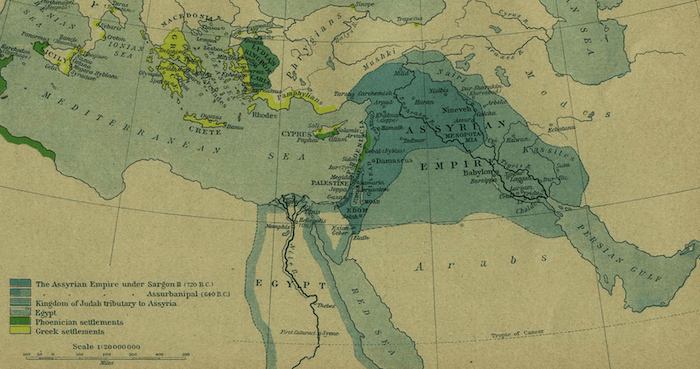
Assyrian Empire Map (750-625 BC) - Historical Atlas (1923)
This made Babylon and the rest of Babylonia an ally of the Assyria regime during this period which allowed for great growth of the empire. By acquiring Babylon peacefully and through mutual benefit the culture of both Babylon and Assyria was able to spread wide throughout the empire at the time, especially through the use of the developed roads at the time. It was during this period that the captured Jews were also able to disseminate their culture and influence on Babylonian life. In conquering the lands of Anatolia and Persia, Assyria was able to open up unrestricted access to all parts of the empire. From the cities of Ionia and Asia Minor all the way down through Mesopotamia, culture, ideas and trade was able to spread across a wider region then ever before.
Military Victories
The successors to king Nirari II also continued the same policy of military conquest and border expansion. Under king Tukulti Ninurta II (891-884 BC) the Assyrians gained ground throughout Anatolia and under Ashur-nasir-pal II (884-859 BC) they were able to even bring Assyrian rule to the civilization of Phoenicia. The common tactic used by the Assyrians was siege warfare which involved using specialized engineers in order to undermine the heavily fortified cities of the region. They developed techniques such as sappers for undermining the structure or they would light fire to wooden structures.
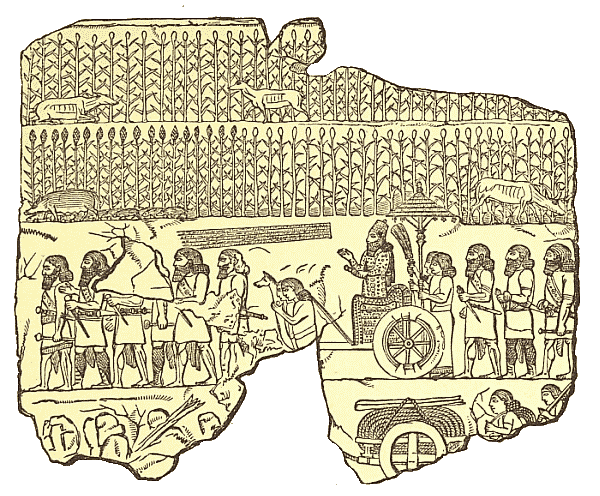
Assyrian King in His Chariot Relief
Ramps and ladders would be used to get soldiers over walls and gates or cross moats. These engineering operations were covered by archers and melee units who supplied military backup. The Assyrians were the first to feature massive wooden siege engines which were wooden multi-story towers on wheels that could be affixed with a battering ram for doors. The siege engines and tactics used by the Assyrians against their enemies would become some of the same used by Alexander many several hundred years later. It is very interesting to note how much history repeats itself and builds upon the past.
Medicine & Education
In addition to advancing warfare and conquering territories, the ancient Assyrians made great advances in the fields of medicine and science. Building upon the ancient knowledge of the Sumerians along with all those they conquered and assimilated, the Assyrians worked to build a codified body of knowledge.
Assyrian king Ashur-nasir-pal II was known as creating the first systematic list of plants and animals throughout the empire and would routinely bring scribes along to document the campaigns and the environment. The Assyrians also built many schools throughout their empire, which while they were only available to the sons of the rich and noble, were great achievements for the time period. While in earlier Mesopotamian cultures women enjoyed equal rights, under Assyrian rule female rights declined.
Ashur-nasir-pal II
Shalmaneser III
Ashur-nasir-pal II was succeeded in rule by Shalmaneser III (859-824 BC) who even further expanded the borders and territories of Assyria and was even able to get the great Phoenician city-states of Tyre and Sidon. to give tribute to Assyria. Shalmaneser III was able to defeat the Armenian kingdom of Urartu which was a longtime enemy of the Assyrian empire.
After the end of his reign however, rule was passed to Shamshi-Adad V (824–811 BC) and a civil war broke out as he fought with his brother over political control. Shamshi-Adad V was successful in putting down the rebellion however, this event had halted the unimpeded growth of Assyria. During this time a Chaldean man named Marduk-apla-usur would seize the throne in Babylonia.
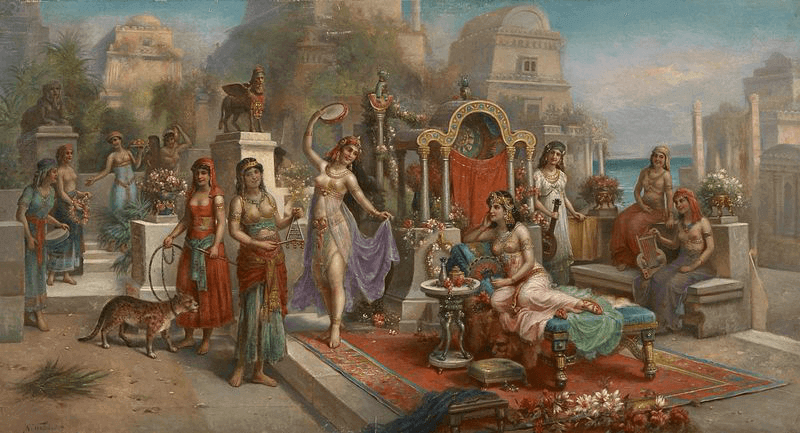
Hanging Gardens of Semiramis - H. Waldeck (c. 1900)
Shamshi-Adad V was succeeded in rule by the regent Shammuramat (811–808 BC) who later became known in lore as the mythical goddess-queen Semiramis. She held the throne for her son Adad Nirari III (811–783 BC) who would assume the throne when he came of age. Adad Nirari III was able to secure the borders of the empire following the civil rebellion and also was able to quash several Mede and other northern rebellion attempts.
Following the reign of Adad Nirari III the throne was passed down to his son Shalmaneser IV (783–773 BC) and the following rulers did not make many achievements towards the Assyrian Empire. Shalmaneser IV was succeeded in rule by Ashur-Dan III (773–755 BC). Under Ashur-Dan III and his successor Ashur Nirari V (755–745 BC) the empire experienced a great period of stagnation which was very harmful to the Assyrian military.
Tiglath-Pileser III
The Neo-Assyria Empire really kicked off under the rule of Tiglath-Pileser III (745-727 BC) however, who was responsible for restructuring the government, the military and making the empire much more efficient. According to ancient texts he carried out massive reform programs within the empire, reconquered much territory around the Mediterranean region and even was able to capture Babylon.

Assyrian Empire Map (750-625 BC) - Historical Atlas (1923)
Instead of conscripting populations like had been the process in the past, Tiglath III decided to demand a certain number of males from each of the vassal states to create his army. Through this new method he was able to conquer part of the Kingdom of Uratu and took over the western portion of Syria. Tiglath III's model for the army and government would become the basis for the three Great Assyrian Kings that would rule after him, creating the largest empire ever known in ancient Mesopotamia.
Tiglath III was followed in rule by Shalmaneser V (727-722 BC) who continued the same policies. Shalmaneser V died while on a military conquest of Samaria in 722 BC.
Sargon II
Shalmaneser V was succeeded by Sargon II (722-705 BC), with some contention to his rule as some viewed it as illegal. However, he was just following in the legacy of Sargon the Great because Assyria was about to reach its zenith under the coming kings. Regardless of the contention the empire stayed unified and Sargon II was able to bring Neo-Assyria to even greater heights.
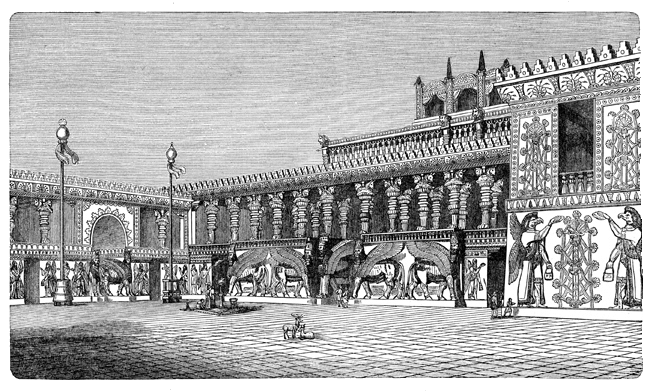
Palace of Sargon Drawing
Sargon II built a new capital city for Assyria at Khorsabad along with his great palace of Dur-Sharrukin which served as the foundation for the later palace that his son Sennacherib would build. The city would be built in a single decade between 716 BC and 706 BC but after the death of Sargon II in battle the capital would be moved to Nineveh.
The city he built in 10 years encompassed a territory of around 9 hectares and all of the buildings were simple thick mud brick walls without windows.
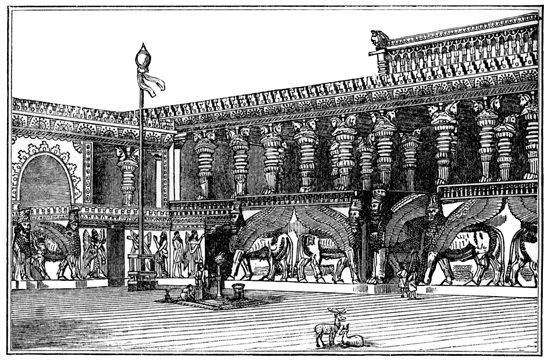
Dur-Sharrukin Drawing
The fortress of Dur-Sharrukin was really an imposing structure. It covered 3 km2 and had seven heavily guarded gates with outposts, turrets and archers. The palace was built along the outer wall of the city. The buildings had openings that led into internal courts such as the Grand Entrance Court and the State Court. The Throne Room of Sargon II was the largest court in the complex with other smaller spaces branching off for women and children. There as also some pools and shade plants but no real garden complex developed here, the architecture was bare in this regard.
Associated with the palace complex was also many religious temples and a massive seven level ziggurat. While splendid and magnificent in its own right, the city would never be fully completed by the time of the Assyrian collapse as the focus would shift to building Nineveh. Given more time this city may have grown to be one of the major regional centers of Mesopotamia.
Urartu-Assyria War
Sennacherib
Sargon II was followed in rule by his son Sennacherib (705-681 BC) who was known as a ruthless conquerer and brilliant military strategist. Sennacherib was able to conquer the areas of Kingdom of Israel, the Kingdom of Judah along with Greek settlements in Anatolia and Babylonia. He was well known for his sack of Jerusalem, most widely noted on the Sennacherib Prism or Taylor Prism, an artifact discovered in 1830 BC by British Colonel Taylor which documents many of Sennacherib's military exploits. According to this ancient text, after capturing 46 other cities in the region, Sennacherib blockaded the people within the city until they were overwhelmed. He then imposed a tribute on them of unimaginable proportions.

Sennacherib Stone Tablet -
The biblical account of the event in Kings II chapters 18-19 says that Jerusalem was saved by divine intervention and it was not captured by the Assyrians but we know that to be false. In fact, most of the accounts of the Jewish scripture appear to whitewash many of the events of the era that do not favor them in the most flattering of light. Alas, there is an entire section where we debunk what the various religious texts say versus the known facts.
As Sennacherib won more and more victories he increased the wealth and scope of his empire and also moved the capital from the city of Ashur to Nineveh. At Nineveh, Sennacherib began public works projects on a scale like no other. He built a magnificent palace and improved upon the cities existing design including adding gardens and other public parks.
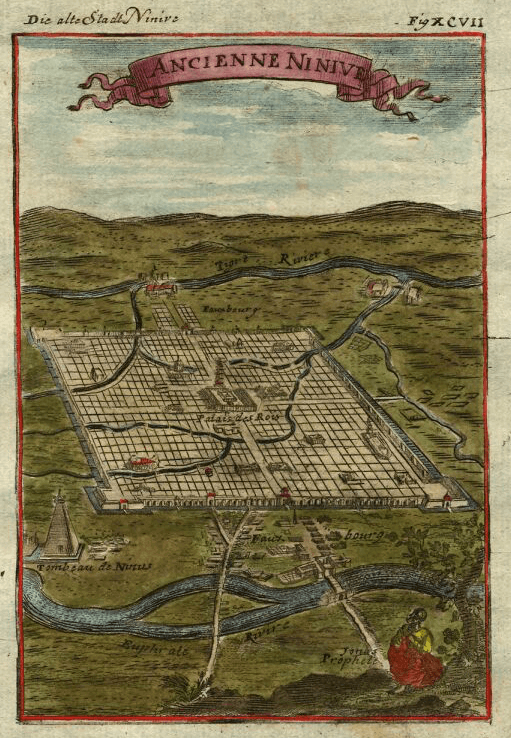
Nineveh - Alain Manesson Mallet (1719)
The new palace at Nineveh was a colossal construction and has even been given by some researchers such as Stephanie Dalley as the site of the mythical Hanging Gardens of Babylon however this is very disputed as the construction of gardens is not a mutually exclusive event in ancient Mesopotamia. In fact the cultures of Babylonia and Assyria are so intertwined sometimes it is very hard to tell them apart.
According to ancient depictions, the palace at Nineveh had over 2,000 carved stone slabs in 71 rooms that documented Assyrian history, culture, achievements and other major events. The gardens in the palace were exceptional with flora from around the empire being gathered. This massive collection of artifacts and culture from throughout the empire would later be greatly developed into the Library of Ashurbanipal.

Palace at Nineveh with Gardens - Dr. Dalley
Hanging Gardens of Ninveh
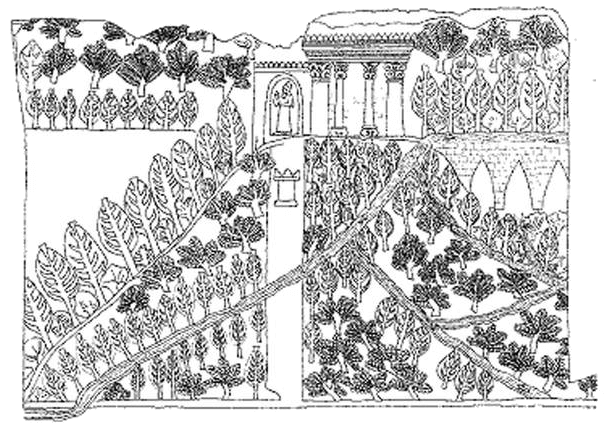
Hanging Gardens at Nineveh - Assyrian Tablet c. 650 BC
Assassination
Repeating history once again however, Sennacherib put down a rebellion by Babylon violently and in a violent rage sacked it, looted its temples and razed it to the ground. As shown with Tukulti-Ninurta I (1233–1197 BC), Sennacherib was also assassinated following his destruction of Babylon. There are some who believe this may have been a secondary reason that contributed to slight instability within the court and religious officials which enabled usurpers to end his life and make a grab at the throne. The destruction of Babylon may have been seen as a great act of blasphemy in accordance with ancient religion and gave his sons all the reason to overthrow him and assume power. They may have been jealous for being passed over in succession of rule and seized this opportunity to gain control.
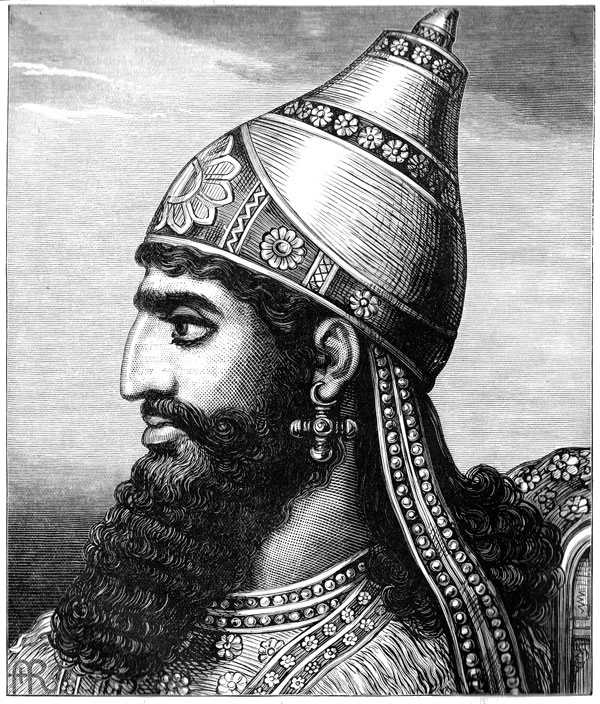
Sennacherib Drawing -
Regardless of the reason Sennacherib was assassinated by some of his sons and supporters that had rallied behind him in an attempt to take the throne. However, his legitimate heir and son Esarhaddon was away in exile and quickly returned to Nineveh to crush the rebellion. He defeated the rebellion soundly and executed all of the supporters and their families. Reasserting control over Nineveh he quickly consolidated power and ruled successfully becoming the next Great King.
Esarhaddon
One of the first things that Esarhaddon (681-669 BC) would do upon becoming king of Assyria was launch a major project to rebuild the city of Babylon that his father had decimated previously. It is during this time period that we lost the location of Old Babylon as the rocks were strewn far across the desert. The city to be rebuilt was the model for what we now know as Babylon that was greatly developed under the later Chaldean dynasty following the conquest of Assyria.
According to ancient accounts Esarhaddon issued an official proclamation that said Babylon was destroyed by the gods for its wickedness and lack of respect for the gods. This may be noted as one of the first known blatant government coverups in history. His proclamation never mentions his father causing the destruction and also destines Esarhaddon as the rightful person to restore Babylon. This was probably done in an effort to add even more credibility to his rule and gain many more supporters given religious people probably hated the Assyrian government at this time. Since Babylon held great religious significance, it was imperative to rebuild the city to regain the support of the population.
Under the reign of Esarhaddon the civilization of Assyria flourished. He was able to conquer Egypt and push as far south as Nubia where he conquered the Kush civilization that occupied both. As soon as Esarhaddon would leave the Kushites would rebel and his son would be forced to reconquer them. He was able to extend the borders as far north as the Zagros Mountains and developed the Assyrian empire greatly domestically as well.

Assyrian Transport of the Winged Bull Relief
Under Esarhaddon's rule Assyria developed great advances in the area of medicine, literacy, math, astronomy, architecture and the arts. At this point Assyria equaled or surpassed the cultural superiority of Babylon and was able to continue this trend with wealth gained from the cities of Ashur, Kalakh and Nineveh. There were artisans and craftsman that produced jewelry for nobles, kings and the palaces became even more decorated with religious adornments.
Ashurbanipal
Esarhaddon died in 668 BC while preparing to campaign against the Nubians in Africa. Rule was transferred to Ashurbanipal (668-627 BC) who was the next and last "Great King of Assyria". He was able to rule because of a treaty his grandmother Naqia/Zakutu had set in place with the Achaemenids and the Medes to recognize his right to rule and submit to Assyria. This treaty was known as the Loyalty Treaty of Naqia/Zakutu ensured the peaceful transition of power between Esarhaddon and Ashurbanipal.
Ashurbanipal is well known as being the most literate of the great kings and created the great Library of Ashurbanipal in the palace at Nineveh to store vast amounts of ancient knowledge in the form of clay tablets. At some point during his rule Ashurbanipal was known to have sent envoys to all the cities and towns within the empire in order to have all their literary works brought to the central library at Nineveh.
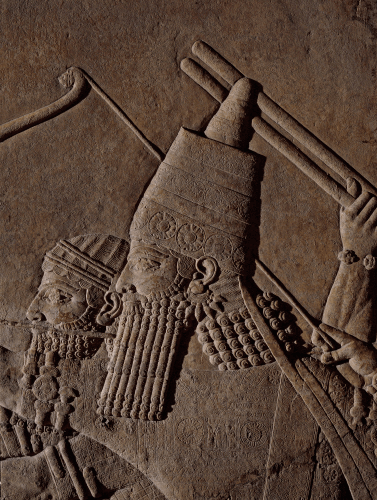
Ashurbanipal Bas Relief -
Ashurbanipal was a great patron of the arts and culture but he was also just as ruthless as his predecessors in maintaining the security of the empire. He was able to successfully defeat the Elamites and eliminated their civilization along with expanding the empire even further than Esarhaddon had been able to. During his period of rule he was able to continue the military campaigns of his predecessors along with presiding over a period of stability for 42 years. However, upon his death the empire his successors were unable to maintain this and the civilization was destroyed by rebelling Babylonians.

Ashurbanipal & His Queen Relief
Babylonian Revolution
Egypt
Overall, Egypt would continue to be dominated by the Assyrians until briefly reasserting control under the last native dynasty of Egyptians following the death of Ashurbanipal. Throughout the Third Intermediate Period the civilization of Egypt would continuously be ruled by foreign powers following the collapse of the native dynasty to the Achaemenid Empire and later Alexander the Great.
Ashurbanipal was able to expel the Kushite dynasty of both Nubia and Egypt once and for all during his military campaign. In conquering Egypt for good this time he was able to bring about the end of the Egyptian Dark Ages that had occurred with the significant Bronze Age Collapse that occurred in the 12th century for Egypt. This would bring Egypt under Assyria's brief control and bring about a revitalization of its economy and culture by connecting it to the massive trade networks of the Assyrian Empire.
Despite ruling over a period of stability, the cracks began to show during Ashurbanipal's rule. Over the course of the Assyrian Golden Age the empire had grown far too large to manage and it cost a great deal to maintain internal security of the vast borders along with the infrastructure necessary to facilitate transportation and communication. Having a massive army it was simply not enough to keep every fort and outpost stationed and eventually the empire began to deteriorate and vassal city-state territories rebelled and broke away.
Collapse
After Ashurbanipal's death he was succeeded by a series of weak an ineffective rulers starting with Ashur-etli-ilani (631–627 BC), then Sin-shumu-lishir (626 BC) and finally Sin-shar-ishkun (627–612 BC) who were unable to prevent this process from occurring and many more regions began to declare their independence from the empire. This would be the death knell for the Assyrian Empire and left them ripe for a major armed rebellion from many previously oppressed city-states and ethnic groups.
Legacy
Assyrian King List
